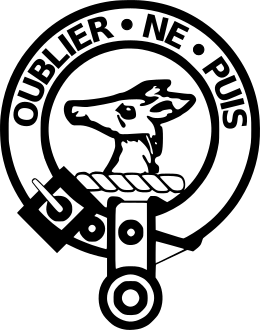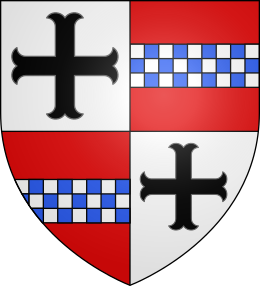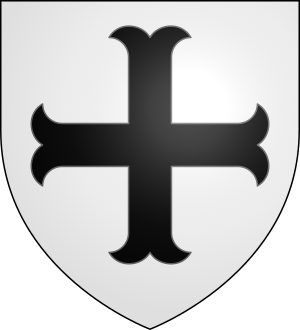Clan Colville facts for kids
Quick facts for kids Clan Colville |
|||
|---|---|---|---|
 |
|||
| Motto | Oblier ne puis (I cannot forget) | ||
| Chief | |||
 |
|||
| Charles Colville | |||
| The Rt Hon The Viscount Colville of Culross | |||
| Historic seat | Kinnaird Castle | ||
|
|||
Clan Colville is an old and important Scottish clan from the Lowlands of Scotland. Clans are like big families that share a common ancestor and a special history. The Colville family has a long and interesting past, with many members playing important roles in Scottish history.
Contents
History
Where Did the Colvilles Come From?
The Colville chiefs came from Normandy, a region in France. Their name probably comes from a town called Colville there.
The first Colville in Scotland was Philip de Colville. He was mentioned in old documents around 1159. In 1174, Philip was one of the people held as a hostage. This was to help release William the Lion, the King of Scotland, from prison. Philip also received land in Roxburghshire and Ayrshire.
Philip's son, Thomas de Colville, was also important. He was a witness to many of King William the Lion's official papers. Thomas was once wrongly accused of treason and put in Edinburgh Castle. But he later got back into the king's good graces. He died peacefully on his own land in 1219.
Thomas's son, William de Colville, gained the area of Kinnaird in Stirlingshire. This place is still the home of the clan chief today.
The Colvilles in the 1300s and 1400s
In 1324, Robert Colville, who was a baron, gave land to Melrose Abbey. He also made donations to the monks of Kelso Abbey.
In 1436, Thomas Colville of Oxnam was chosen for a special journey. He went with Princess Margaret, the daughter of James I of Scotland. She was traveling to France to marry the Dauphin of France, who later became King Louis XI of France.
A sad event happened in 1449. Sir Richard Colville killed John Auchinleck. Auchinleck was a favorite of the Earl of Douglas, who was the chief of Clan Douglas. To get revenge, the Earl of Douglas attacked Colville's lands. He also took Kinnaird Castle, causing many lives to be lost.
The Colvilles in the 1500s and 1600s
In 1513, Robert Colville of Hilton died fighting at the Battle of Flodden. His son, Sir James Colville of Ochiltree, became a very important person. In 1527, he was put in charge of the Royal Household's money.
Later, Sir James exchanged his lands for new ones. He also became a judge in Scotland's highest court. However, he was later accused of treason. His lands were taken by the Crown. But in 1543, the accusation was removed, and he got his lands back.
Another Sir James Colville, the third of Easter Wemyss, was a brave soldier. He fought in France for the Prince of Navarre, who later became King Henry IV of France. In 1604, Sir James Colville was given a special title: 'Lord Colville of Culross'. The clan chiefs still use this title today.
The Colvilles in the 1700s
Fighting in Europe
In 1709, John Colville, who was the seventh Lord Colville, fought as a soldier. He was at the Battle of Malplaquet, a big victory for the British. In 1723, he officially became Lord Colville. He continued his military career. He died in 1741 during the siege of Cartagena. Many of his children also had successful military careers.
The Jacobite Risings
During the Jacobite rising of 1745, Charles Colville supported the British government. He led a regiment of soldiers at the Battle of Culloden in 1746. He became a lieutenant general before he died in 1775.
The Seven Years' War
In 1731, Alexander Colville, 7th Lord Colville of Culross joined the Navy. By 1744, he was captain of a large ship called HMS Leopard (1741). He later became a commodore. In 1755, he sailed to America during the Seven Years' War. In 1759, Colville made the French stop their attack on Quebec. He was promoted to Vice Admiral in 1769.
The Colvilles in the 1800s and 1900s
Charles Colville was a brave soldier. He fought well in the Peninsular War and at the famous Battle of Waterloo. His son, Charles Colville, 1st Viscount Colville of Culross, inherited the title. This Charles Colville was a special helper to Queen Victoria. He was also a high-ranking official for Queen Alexandra of Denmark. In 1902, he was given the new title of Viscount Colville of Culross.
The brother of the second Viscount was Sir Stanley Colville. He was a rear admiral in the Navy. He was in charge of the Portsmouth naval base from 1916 to 1919. Stanley Colville received some of the highest honors in the country for his service.
The Clan Today
Mark Colville, who was the 13th Lord Colville of Culross, became chief in 1945. He worked as a government minister and was part of the UN Human Rights Commission. He passed away in 2010.
His son, Charles Colville, is now the 14th Lord Colville of Culross. He is a member of the House of Lords and is the current Clan Chief.
See also


